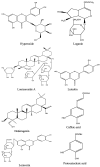Lonicera japonica Thunb.: ethnopharmacology, phytochemistry and pharmacology of an important traditional Chinese medicine
- PMID: 21864666
- PMCID: PMC7127058
- DOI: 10.1016/j.jep.2011.08.016
Lonicera japonica Thunb.: ethnopharmacology, phytochemistry and pharmacology of an important traditional Chinese medicine
Abstract
Ethnopharmacological relevance: Lonicera japonica Thunb. (Caprifoliaceae), a widely used traditional Chinese medicine, was known as Jin Yin Hua (Chinese: ), Ren Dong and Japanese honeysuckle. It was taken to treat the exopathogenic wind-heat, epidemic febrile diseases, sores, carbuncles and some infectious diseases. At the same time, Lonicera japonica could be used as healthy food, cosmetics, ornamental groundcover, and so on.
Aim of the review: The present paper reviewed the ethnopharmacology, the biological activities, toxicology and phytochemistry of Lonicera japonica.
Materials and methods: Information on Lonicera japonica was gathered via the Internet (using Google Scholar, Baidu Scholar, Elsevier, ACS, Medline Plus, CNKI and Web of Science) and libraries. Additionally, information also was obtained from some local books and brilliant scholars on ethnopharmacology.
Results: More than 140 chemical compounds have been isolated, and the main compositions are essential oils, organic acids and flavones, etc. Lonicera japonica and its active principles possess wide pharmacological actions, such as anti-inflammatory, antibacterial, antiviral, antioxidative and hepatoprotective activities.
Conclusions: As an important traditional Chinese medicine, further studies on Lonicera japonica can lead to the development of new drugs and therapeutics for various diseases, and how to utilize it better should be paid more attentions.
Copyright © 2011 Elsevier Ireland Ltd. All rights reserved.
Figures
References
-
- Ardó L., Yin G.J., Xu P., Váradi L., Szigeti G., Jeney Z., Jeney G. Chinese herbs (Astragalus membranaceus and Lonicera japonica) and boron enhance the non-specific immune response of Nile tilapia (Oreochromis niloticus) and resistance against Aeromonas hydrophila. Aquaculture. 2008;275:26–33.
-
- Bassoli B.K., Cassolla P., Borba-Murad G.R., Constantin J., Salgueiro-Pagadigorria C.L., Bazotte R.B., da Silva R.S.d.S.F., de Souza H.M. Chlorogenic acid reduces the plasma glucose peak in the oral glucose tolerance test: effects on hepatic glucose release and glycaemia. Cell Biochemistry and Function. 2008;26:320–328. - PubMed
-
- Cao C.P., Huang Z.N., Qian P.L., Pan X.X. Studies on the anti-pregnant effect of the Lonicera japonica thunb extract. Pharmaceutical Industry. 1986;17:115–117. (in Chinese)
-
- Cao C.P., Huang Z.N., Qian P.L., Yan D.P., Shen Y.P., Pan X.X. Pharmacological study of pregnancy termination effect of Lonicera japonica thunb. Pharmaceutical Industry. 1986;17:319–321. (in Chinese)
Publication types
MeSH terms
Substances
LinkOut - more resources
Full Text Sources
Other Literature Sources
Medical
Research Materials




